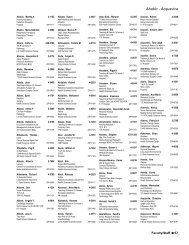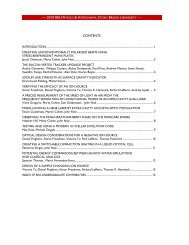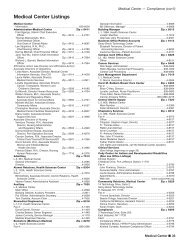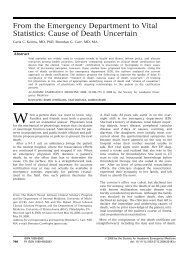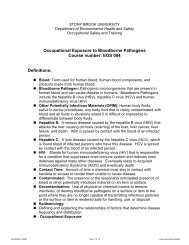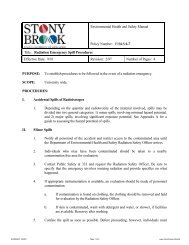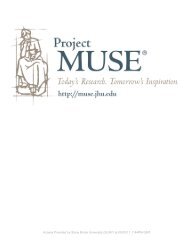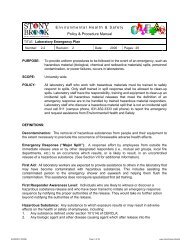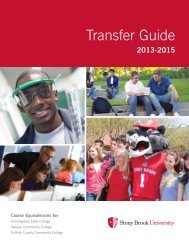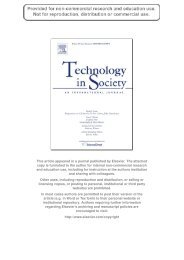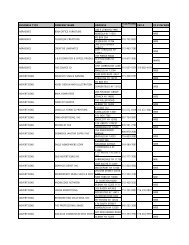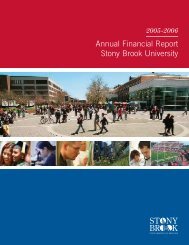Planning Guide - Stony Brook University
Planning Guide - Stony Brook University
Planning Guide - Stony Brook University
Create successful ePaper yourself
Turn your PDF publications into a flip-book with our unique Google optimized e-Paper software.
Freshman Courses and Course Descriptions<br />
Listed below are the courses and course descriptions of freshman-level classes that are part of <strong>Stony</strong> <strong>Brook</strong>’s<br />
DEC (Diversified Education Curriculum) requirements. This information will be particularly helpful to you<br />
when filling out the Registration <strong>Planning</strong> Form (pages 15 to 17 of this <strong>Guide</strong>).<br />
HUMANITIES COURSES<br />
AAS 110 Appreciating Indian Music<br />
An introduction to the basic elements of<br />
Indian classical music, such as “raga” and “tala”;<br />
“gharanas” (schools); and styles. Vocal and<br />
instrumental masterpieces are studied. Topics<br />
include the roles of stringed and percussion<br />
instruments; the intimate relationship between<br />
music and religion, and music and ethnicity; and<br />
the influence of Indian classical music on contemporary<br />
art forms such as film and folk music.<br />
No previous musical training is required.<br />
AMR 101 Local and Global: National<br />
Boundaries and World-Systems<br />
Introduction to the contemporary capitalist<br />
world-system as a complex network of unequal<br />
power relationships and its inextricable role in<br />
our daily lives. Consideration of the ways the<br />
Americas have been incorporated into the<br />
world-system through colonialism and early<br />
capitalist ventures, with emphasis on the 20th<br />
century in terms of transnationalism, globalization,<br />
and the mobility of capital and labor,<br />
especially as this creates racial formations.<br />
CCS 101 Images and Texts:<br />
Understanding Culture<br />
The images and texts of advertising, television,<br />
art, writing, film, and performance and how they<br />
come to characterize and shape our everyday<br />
lives. Using case studies, students learn how<br />
to recognize, read, and analyze culture within<br />
a particular social, cultural, or political context,<br />
touching upon such important issues as race,<br />
gender, class, ideology, and censorship.<br />
CLS 113 Greek and Latin Literature<br />
Historical and analytical study of the development<br />
of classical Greek and Latin literature.<br />
Extensive readings in translation include<br />
works illustrating epic, lyric, drama, history,<br />
oration, and literary criticism.<br />
HUM 121 Death and Afterlife<br />
in Literature<br />
Through discussion of representative contemporary<br />
and classical texts, this course addresses<br />
the topic of how human beings have chosen to<br />
live with the one certainty of their existence, its<br />
eventual conclusion in death, and how various<br />
images of afterlife or denial of its possibility<br />
have shaped those choices.<br />
12<br />
HUM 122 Images of Women<br />
in Literature<br />
An historical examination of selected representations<br />
of women in world literature ranging from<br />
classical literature to modern evocations of<br />
women’s changing social roles and the rise of<br />
feminine self-consciousness.<br />
HUM 123 Sexuality in Literature<br />
An exploration of the expression and interpretation<br />
of sexual experience in literature and culture,<br />
through discussion of selections from world literature<br />
and art, both classic and contemporary.<br />
Themes include temptation and gratification,<br />
desire and fulfillment, and how societies shape<br />
gender roles and deviance and set limits on sexual<br />
representation in literature and art.<br />
HUR 141 The Age of Empire<br />
A survey in English of major Russian writers of<br />
the 19th and 20th centuries, including Pushkin,<br />
Dostoevsky, and Solzhenitsyn. A brief history of<br />
Russian literary masterpieces in the context of<br />
world literature and of major cultural movements<br />
such as the Renaissance, the Enlightenment, and<br />
20th-century totalitarianism.<br />
JRN 101 News Literacy<br />
How do you know if you’re getting the truth from<br />
the news media? This course is designed to prepare<br />
students to become more discriminating<br />
news consumers. It will examine standards of<br />
reliability and accuracy in news gathering and<br />
presentation, and seek to establish the differences<br />
between news and propaganda, assertion<br />
and verification, bias and fairness, and infotainment<br />
and journalism. Students will be encouraged<br />
to critically examine news broadcasts,<br />
newspaper articles, and Web sites. Visiting journalists<br />
will be questioned about the journalistic<br />
process and decision-making.<br />
PHI 100 Concepts of the Person<br />
An historical introduction to philosophy through<br />
readings and discussion on topics such as<br />
human identity, human understanding, and<br />
human values.<br />
PHI 104 Moral Reasoning<br />
An introduction to philosophy through inquiry<br />
into the formation, justification, and evaluation of<br />
moral judgments. Students are introduced to the<br />
major theories and problems of ethics, such as<br />
utilitarianism, Kant’s categorical imperative, ethical<br />
relativism, egoism, and classical conceptions<br />
of the good and virtue. Against this background<br />
students engage in discussions of contemporary<br />
moral issues.<br />
PHI 105 Politics and Society<br />
An historical introduction to philosophy through<br />
an analysis of political theories, theories of<br />
action, and styles of political life. Themes include<br />
the relation of the individual to the state, the<br />
scope of social responsibility, and the nature of<br />
human freedom.<br />
PHI 108 Logical and Critical<br />
Reasoning<br />
The principal aim of this course is to help a student<br />
acquire the skills of thinking, reading, and<br />
writing critically. The student develops a sensitivity<br />
to language and argumentation that is applicable<br />
to a wide range of situations and subject matters.<br />
PHI 109 Philosophy and Literature<br />
in Social Context<br />
The role of literature and philosophy in understanding<br />
and critically assessing personal experience<br />
and social life.The links among literary texts,<br />
philosophical issues, and political and social<br />
commitments are explored. Topics include the<br />
relations between language and experience, the<br />
role of philosophical thinking through literary<br />
texts, and the significance of literary expression in<br />
different cultural and historical situations.<br />
RLS 101 Western Religions<br />
An historical introduction to Judaism, Christianity,<br />
and Islam. Attention is given to the cultural<br />
background, art, literature, philosophy, and<br />
institutional development of each tradition.<br />
RLS/AAS 102 Eastern Religions<br />
An historical introduction to Hinduism, Buddhism,<br />
Confucianism, and Taoism. Attention is given to<br />
the cultural background, art, literature, philosophy,<br />
and institutional development of each tradition.<br />
THR 104 Play Analysis<br />
A close reading of several plays of different periods<br />
and styles and a general examination of<br />
the elements out of which all plays are made—<br />
dialogue, character, plot.<br />
WST 103 Women, Culture,<br />
andDifference<br />
An introductory humanities survey focusing on<br />
women’s traditional association with the home<br />
and men’s association with public life and how<br />
writers, artists, philosophers, and religious<br />
thinkers have reflected upon those relationships<br />
over the past 150 years. Through lectures and<br />
critical analyses of novels, poetry, art, philosophy,<br />
and religious texts, the course explores how<br />
changing intellectual, artistic, and religious<br />
precepts have affected gender identity and<br />
different genres in the humanities.



